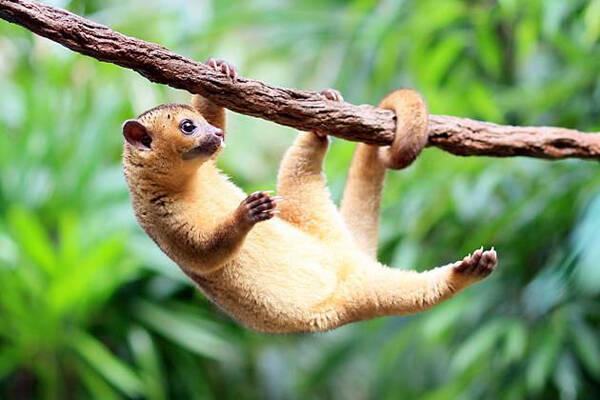Potos flavus
IUCN
LCBasic Information
Scientific classification
- name:Potos flavus
- Scientific Name:Potos flavus,Kinkajou,Panda
- Outline:Carnivora
- Family:Spinopoda Procyonidae Nephilininae Nephilinidae
Vital signs
- length:40-60cm
- Weight:2-4.6kg
- lifetime:29-49years
Feature
Their fur is usually golden, their tongue is long, and they can make a woman-like scream.
Distribution and Habitat
Honey bears are mainly distributed in Belize, Brazil, Colombia, Costa Rica, Ecuador, El Salvador, French Guiana, Guatemala, Guyana, Honduras, Mexico, Nicaragua, Panama, Peru, Suriname, Venezuela (Bolivarian Republic), etc.
Honey bears live in a variety of forest habitats. Including tropical dry forests, secondary forests, Amazon rainforests, Atlantic coastal forests, tropical evergreen forests and forest-steppe areas.
Appearance
The honey bear is 40~60 cm long, the tail is 40~60 cm long, and the weight is 2~4.6 kg. The male is slightly larger than the female. The outer fur is usually golden, and other color variants have been found.
The head can rotate 180° and the tongue is up to 13 cm long. The eyes are big, the ears are small, the trunk is short, the legs are slender, and the tail is flexible, which can be used to hang on the tree. The claws are sharp and flexible, which can firmly grasp the tree trunk. The hind legs can be flipped backwards, and the spine is flexible and soft, which can shuttle between branches. These are the guarantees of the honey bear's arboreal life; when the honey bear's front paws are used for eating, it can still be stabilized on the tree with the tail and hind limbs. Honey bears can often be seen hanging upside down on the tree to eat. The honey bear is 40~60 cm long, the tail is 40~60 cm long, and the weight is 2~4.6 kg. The male is slightly larger than the female. Th
Details
Kinkajou (Latin name: Potos flavus, English name: Kinkajou) is a species of raccoon that lives in the rainforest. It is the only species in the genus Kinkajou and has 7 subspecies.

Honey bears are nocturnal, arboreal animals that are most active from 7pm to midnight and an hour before dawn. They sleep in tree holes or under the shade during the day. Their tails can hold onto things and help them climb trees. They do not use their tails to catch food. The scent glands near the mouth, throat, and abdomen can be used to mark territory and walking routes. Honey bears live in groups. They often forage alone, but sometimes they forage in groups or with raccoons.
Honey bears are omnivorous, have sharp teeth, and mainly eat fruit, but sometimes also eat bird eggs, insects and birds. Honey bears have tongues up to 13 cm long, which they use to pick fruit or eat nectar from flowers. Honey bears in captivity have eaten honey, but there is no record of this in the wild.
Honey bears communicate with different sounds. Their calls are high-pitched, like a woman's scream. They have a very sensitive sense of touch and smell, but poor vision and cannot distinguish colors. Honey bears usually use the scent secreted by glands to mark territory and leave messages.
Honey bears are polyandrous or polygamous, usually one female and two males and their offspring form a group. Males usually use calls and smells to attract the attention of females, and will fight with other males. The estrus period of females is usually 17 days, which varies slightly in different habitats. They can reproduce all year round, and males are dominant. Cubs are born alive, with an average of 1 to 2 cubs per litter, and the gestation period is 98 to 120 days. Cubs are weaned 8 weeks after birth, and sexual maturity is achieved after 820 days for females and 550 days for males; they can live independently after 4 months, and are mainly fed by females. The average lifespan of wild honey bears is 29 years old, and can reach up to 49 years old in captivity. The reproduction rate in the wild is extremely low.
Because the nectar is a tree-dwelling animal, it is impossible to accurately know the exact number of nectar bears in the wild. However, due to the expansion of human settlements and deforestation, the nectar bear's range of activities has gradually shrunk, and human desire for its fur and meat has made the nectar bear threatened by humans. The main natural enemies are eagles and jaguars.
Protect wild animals and eliminate game.
Maintaining ecological balance is everyone's responsibility!








